Middleton W.M. (ed.) Reference Data for Engineers: Radio, Electronics, Computer and Communications
Подождите немного. Документ загружается.

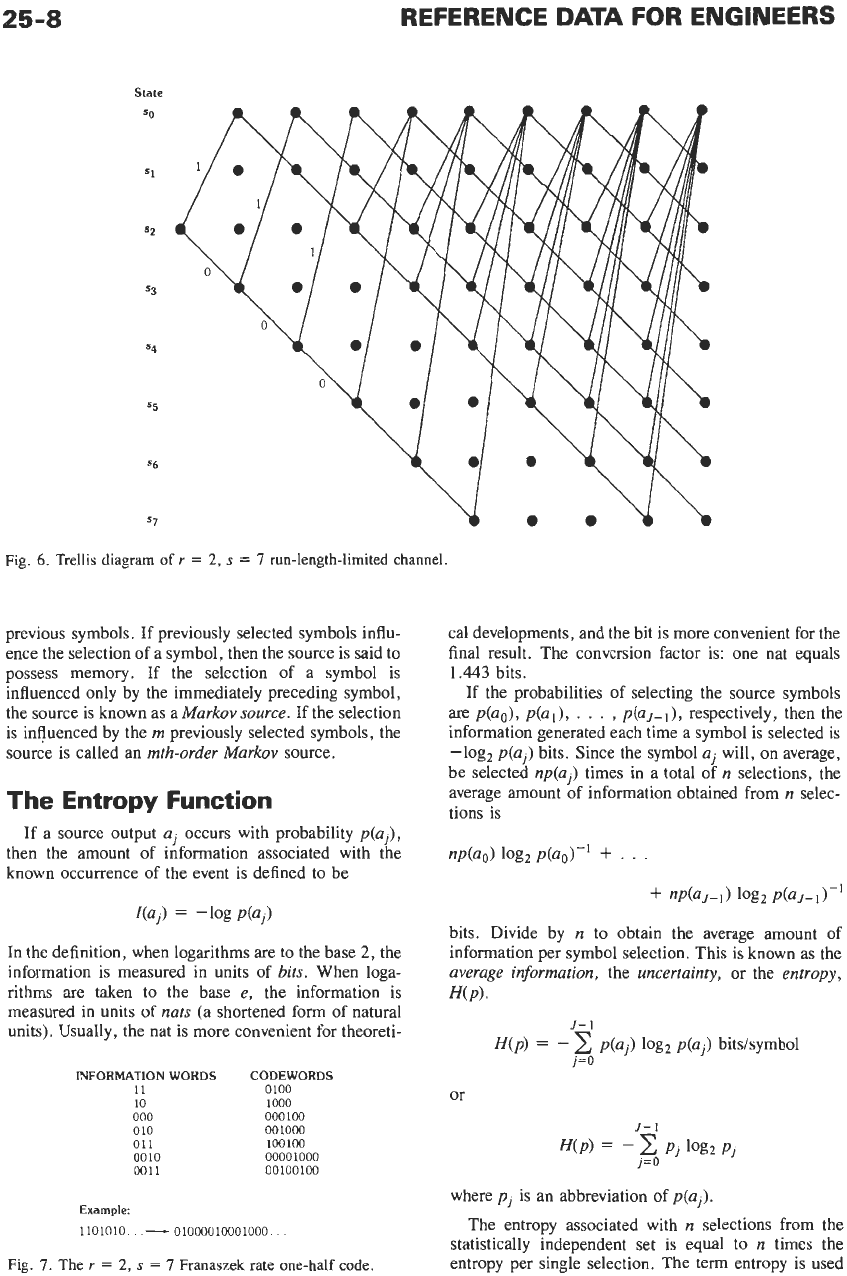
25-8
REFERENCE
DATA
FOR ENGINEERS
State
SO
Fig.
6.
Trellis diagram
of
r
=
2,
s
=
7
run-length-limited channel.
previous symbols. If previously selected symbols influ-
ence the selection of a symbol, then the source is said to
possess memory. If the selection of a symbol is
influenced only by the immediately preceding symbol,
the source is known as a
Markov source.
If
the selection
is influenced by the
m
previously selected symbols, the
source
is
called an
mth-order Markov
source.
The
Entropy
Function
If a source output
ai
occurs with probability
p(aj),
then the amount of information associated with the
known occurrence of the event is defined to be
qui)
=
-logp(uj)
In the definition, when logarithms are to the base
2,
the
information
is
measured in units of
bits.
When loga-
rithms are taken to the base
e,
the information is
measured in units
of
nuts
(a shortened form
of
natural
units). Usually, the nat is more convenient for theoreti-
INFORMATION WORDS CODEWORDS
11 0100
10 1000
000 000100
010 001000
011
100100
0010 00001000
0011 00100100
Example:
1101010
-
01000010001000
Fig.
7.
The
r
=
2,
s
=
7
Franaszek
rate one-half code.
cal developments, and the bit is more convenient for the
final result. The conversion factor is: one nat equals
1.443
bits.
If the probabilities of selecting the source symbols
are
p(uO),
p(al),
.
.
.
,
P(U~-~),
respectively, then the
information generated each time a symbol is selected
is
-log2
p(uj)
bits. Since the symbol
ai
will, on average,
be selected
np(uj)
times in a total of
n
selections, the
average amount of information obtained from
n
selec-
tions is
nP(ao)
log2
P(ao1-I
+
’
.
,
+
nP(a.I-l)
log2
p(aJ-l)-l
bits. Divide by
n
to obtain the average amount of
information per symbol selection. This
is
known as the
average information,
the
uncertainty,
or the
entropy,
WP).
.I-1
j=O
H(p)
=
-
p(ui)
log,
p(uj)
bitsisymbol
or
J-
I
H(P)
=
-
c
Pj
1%
pj
j=O
where
pj
is
an abbreviation of
p(a,).
The entropy associated with
n
selections from the
statistically independent set is equal to
n
times the
entropy per single selection. The term entropy is used
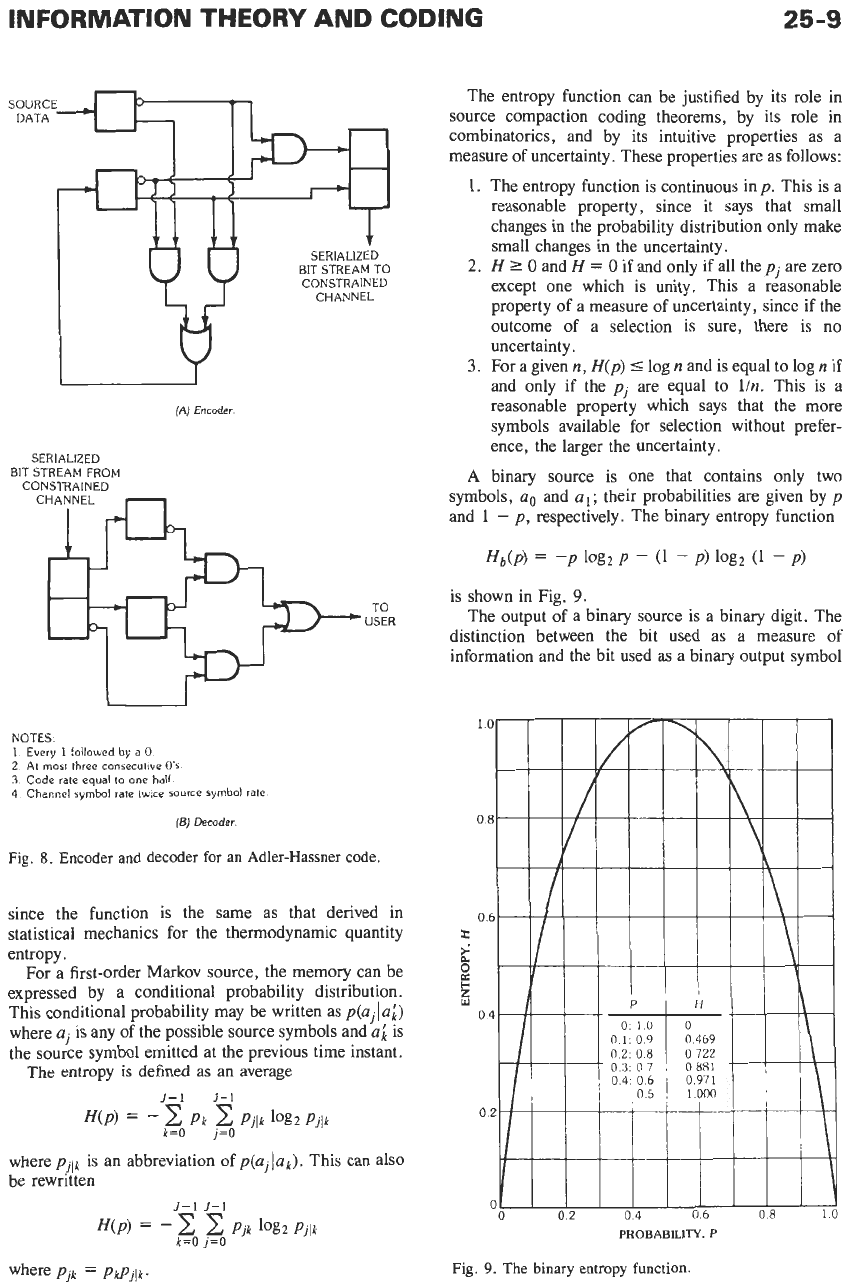
INFORMATION THEORY AND CODING
25-9
SOURCE
DATAc
+
SERIALIZED
BIT
STREAM
TO
CONSTRAINED
(1
CHANNEL
(A)
Encoder
SERIALIZED
BIT
STREAM FROM
CONSTRAINED
SERIALIZED
BIT
STREAM FROM
CONSTRAINED
CHANNEL
TO
USER
NOTES.
1.
Every
1
lollowed by a
0
2.
At most three consecutive
Os
3.
Code rate
equal
to one
half.
4
Channel symbol rate twice
SOUTCB
symbol rate
(B)
Decoder
Fig.
8.
Encoder and decoder for an Adler-Hassner code.
sinte the function is the same as that derived in
statistical mechanics for the thermodynamic quantity
entropy.
For a first-order Markov source, the memory can be
expressed by a conditional probability distribution.
This conditional probability may be written as
p(aj
la;)
where
aj
is any of the possible source symbols and
a;
is
the source symbol emitted at the previous time instant.
The entropy
is
defined as
an
average
where
pjik
is
an abbreviation of
p(ajlak).
This can also
be rewritten
I-1
J-1
H(p)
=
-
Pjk
log2
Pjlk
k=O
j=O
The entropy function can be justified by its role in
source compaction coding theorems, by its role in
combinatorics, and by its intuitive properties as a
measure of uncertainty. These properties are as follows:
1.
The entropy function is continuous in
p.
This is a
reasonable property, since it says that small
changes in the probability distribution only make
small changes in the uncertainty.
2.
H
2
0
and
H
=
0
if and only if all thepj are zero
except one which is unity. This a reasonable
property of a measure
of
uncertainty, since if the
outcome of a selection is sure, there is no
uncertainty.
3.
For a given
n,
H(p)
5
log
n
and is equal to log
n
if
and only if the
pj
are equal to
lln.
This is a
reasonable property which says that the more
symbols available for selection without prefer-
ence, the larger the uncertainty.
A
binary source is one that contains only two
symbols,
a.
and
al;
their probabilities are given by
p
and
1
-
p,
respectively. The binary entropy function
Hb(p)
=
-P
log2
P
-
(1
-
P)
log2
(1
-
P)
is shown in Fig.
9.
The output of a binary source is a binary digit. The
distinction between the bit used as a measure of
information and the bit used as a binary output symbol
1c
OE
Ot
r
!i
2
OL
z
02
0
PROBABILITY.
P
Fig.
9.
The binary entropy function
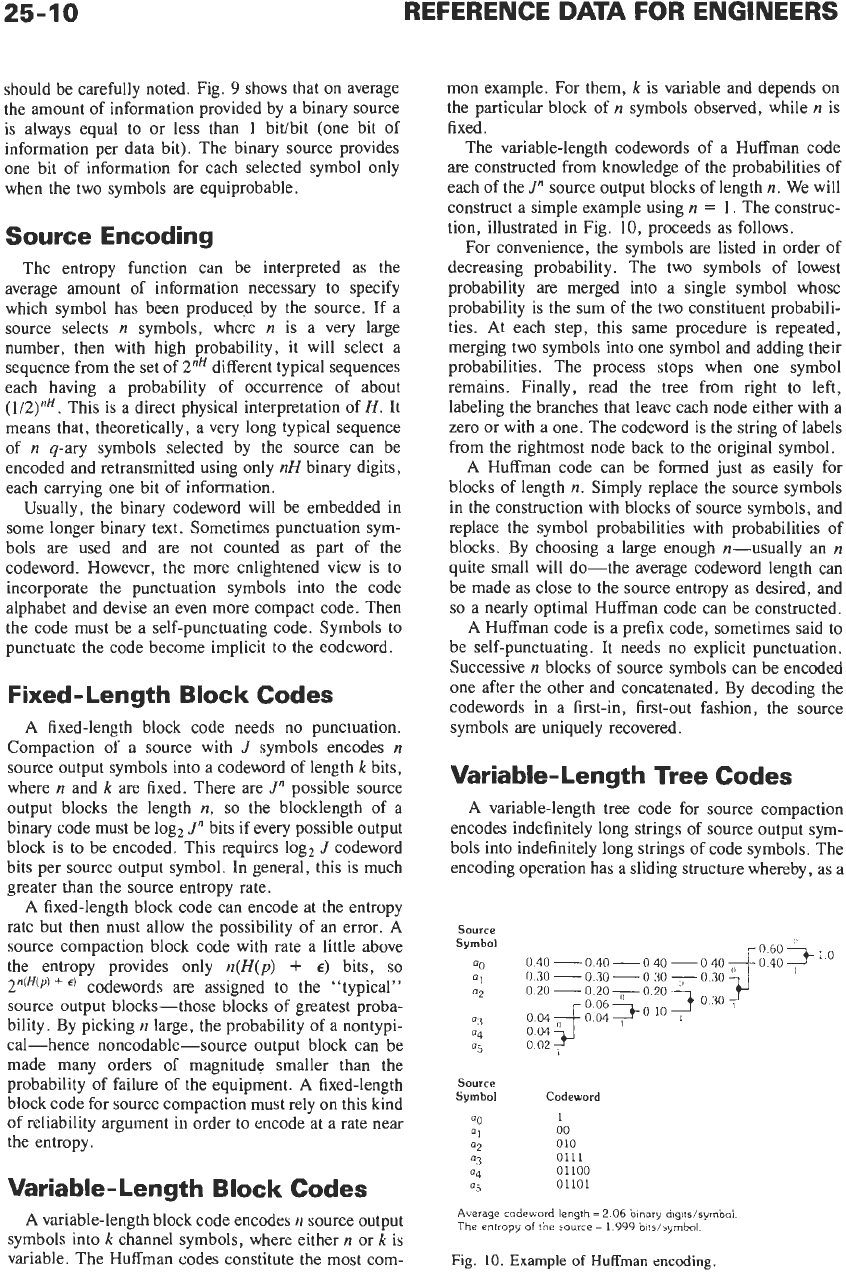
25-10
REFERENCE
DATA
FOR ENGINEERS
should be carefully noted. Fig.
9
shows that on average
the amount of information provided by a binary source
is always equal to or less than 1 bit/bit (one bit of
information per data bit). The binary source provides
one bit of information for each selected symbol only
when the two symbols are equiprobable.
Source Encoding
The entropy function can be interpreted as the
average amount of information necessary to specify
which symbol has been produced by the source. If a
source selects
n
symbols, where
n
is a very large
number, then with high probability, it will select a
sequence from the set of
ZnH
different typical sequences
each having a probability of occurrence of about
(1/2)"H. This is a direct physical interpretation of
H.
It
means that, theoretically,
a
very long typical sequence
of
n
q-ary symbols selected by the source can be
encoded and retransmitted using only
nH
binary digits,
each carrying one bit of information.
Usually, the binary codeword will be embedded in
some longer binary text. Sometimes punctuation sym-
bols are used and
are
not counted as part of the
codeword. However, the more enlightened view is to
incorporate the punctuation symbols into the code
alphabet and devise an even more compact code. Then
the code must be a self-punctuating code. Symbols to
punctuate the code become implicit to the codeword.
Fixed-Length Block Codes
A
fixed-length block code needs no punctuation.
Compaction of a source with
J
symbols encodes
n
source output symbols into a codeword of length
k
bits,
where
n
and
k
are fixed. There are
J"
possible source
output blocks the length
n,
so
the blocklength of a
binary code must be log,
d"
bits if every possible output
block is to be encoded. This requires log,
J
codeword
bits per source output symbol. In general, this is much
greater than the source entropy rate.
A
fixed-length block code can encode at the entropy
rate but then must allow the possibility of an error.
A
source compaction block code with rate a little above
the entropy provides only
n(H(p)
+
E)
bits,
so
2"(H(P)
+
codewords are assigned to the "typical"
source output blocks-those blocks of greatest proba-
bility. By picking
n
large, the probability
of
a nontypi-
cal-hence noncodable-source output block can be
made many orders of magnitude smaller than the
probability of failure
of
the equipment.
A
fixed-length
block code for source compaction must rely on this kind
of reliability argument in order to encode at a rate near
the entropy.
Variable-Length Block Codes
A
variable-length block code encodes
n
source output
symbols into
k
channel symbols, where either
n
or
k
is
variable. The Huffman codes constitute the most com-
mon example. For them,
k
is variable and depends on
the particular block of
n
symbols observed, while
n
is
fixed.
The variable-length codewords of a Huffman code
are constructed from knowledge of the probabilities of
each of the
J"
source output blocks of length
n.
We will
construct a simple example using
n
=
1.
The construc-
tion, illustrated in Fig.
10,
proceeds as follows.
For convenience, the symbols are listed in order
of
decreasing probability. The two symbols of lowest
probability are merged into a single symbol whose
probability is the sum of the two constituent probabili-
ties. At each step, this same procedure is repeated,
merging two symbols into one symbol and adding their
probabilities. The process stops when one symbol
remains. Finally, read the tree from right to left,
labeling the branches that leave each node either with a
zero or with a one. The codeword is the string of labels
from the rightmost node back to the original symbol.
A
Huffman code can be formed just as easily for
blocks of length
n.
Simply replace the source symbols
in the construction with blocks of source symbols, and
replace the symbol probabilities with probabilities of
blocks. By choosing a large enough n-usually an
n
quite small will do-the average codeword length can
be made as close to the source entropy as desired, and
so
a nearly optimal Huffman code can be constructed.
A
Huffman code is a prefix code, sometimes said to
be self-punctuating. It needs no explicit punctuation.
Successive
n
blocks of source symbols can be encoded
one after the other and concatenated. By decoding the
codewords in a first-in, first-out fashion, the source
symbols are uniquely recovered.
Variable-Length Tree Codes
A
variable-length tree code for source compaction
encodes indefinitely long strings of source output sym-
bols into indefinitely long strings of code symbols. The
encoding operation has a sliding structure whereby, as a
Source
Symbol
00
01
02
03
04
05
0
40
-0
40
-0
40
-0
40
0
30
-
0
30
-0
30
-0
30
0
20
-
0
20-0
20
002
*
0
04
Source
Symbol
Codeword
00
1
01
00
02
010
03
0111
a4
01100
05
01101
Average
codeword
length
=
2
06
bmary
d!gds/symbol.
The
entropy
of
the
source
=
1
999
biis/syrnbol.
Fig.
10.
Example
of
Huffman
encoding.
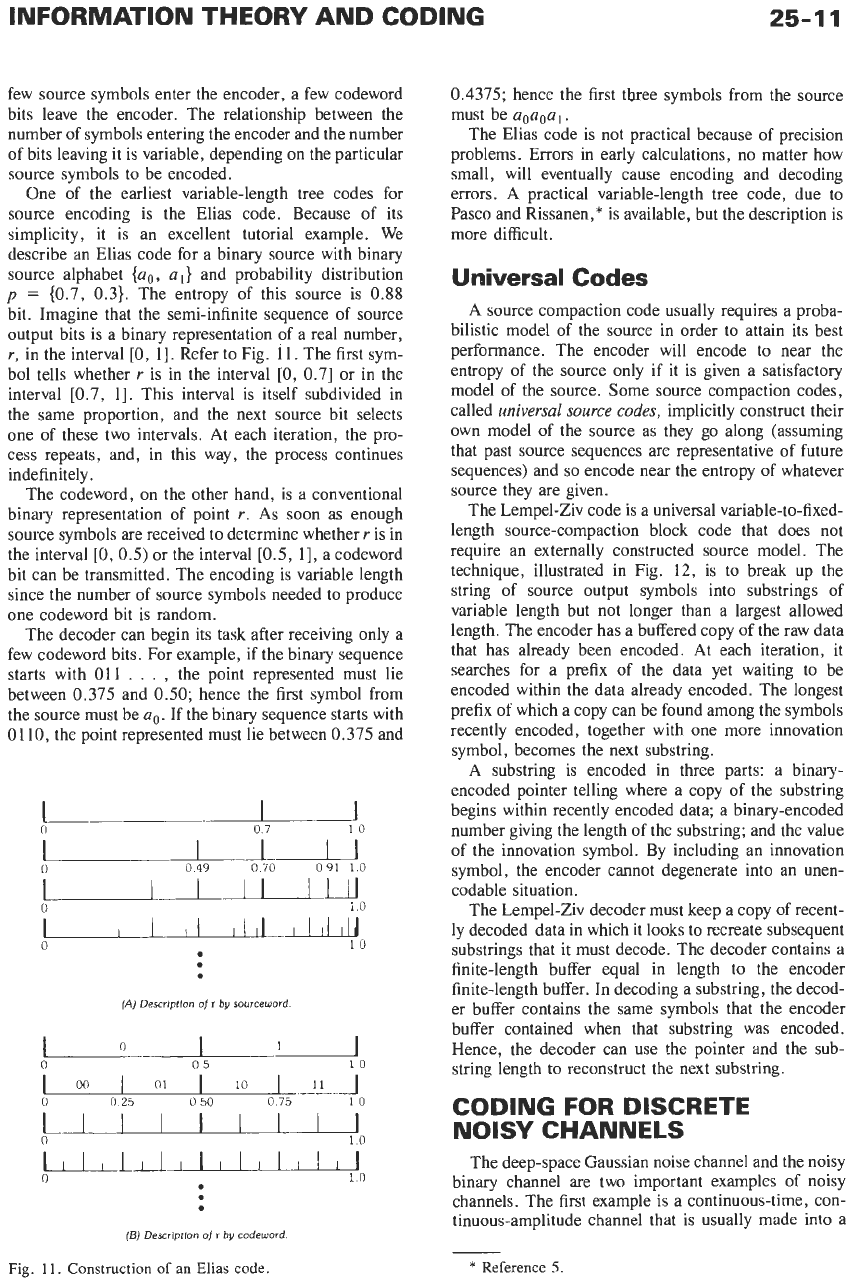
INFORMATION THEORY AND CODING
25-1
1
00
01
10
few source symbols enter the encoder, a few codeword
bits leave the encoder. The relationship between the
number of symbols entering the encoder and the number
of bits leaving it is variable, depending
on
the particular
source symbols to be encoded.
One of the earliest variable-length tree codes for
source encoding is the Elias code. Because
of
its
simplicity, it is an excellent tutorial example. We
describe
an
Elias code for a binary source with binary
source alphabet
{ao,
a
I}
and probability distribution
p
=
(0.7,
0.3). The entropy of this source is
0.88
bit. Imagine that the semi-infinite sequence of source
output bits is a binary representation of a real number,
r,
in the interval
[0,
11.
Refer to Fig.
11.
The first sym-
bol tells whether
r
is in the interval
[0,
0.71 or in the
interval [0.7,
11.
This interval is itself subdivided in
the same proportion, and the next source bit selects
one of these two intervals. At each iteration, the pro-
cess repeats, and, in this way, the process continues
indefinitely.
The codeword, on the other hand, is a conventional
binary representation of point
r.
As soon as enough
source symbols are received to determine whether
r
is in
the interval
[0,
0.5)
or the interval
[0.5,
11,
a codeword
bit can be transmitted. The encoding is variable length
since the number of source symbols needed to produce
one codeword bit is random.
The decoder can begin its task after receiving only a
few codeword bits. For example, if the binary sequence
starts with
011
. . .
,
the point represented must lie
between 0.375 and
0.50;
hence the first symbol from
the source must be
ao.
If the binary sequence starts with
01
10,
the point represented must lie between 0.375 and
11
0
10
.
0
0
(A)
Description
of
I
by
sourceword
(E)
Descrlptlon
of
r
by
codeword.
Fig.
11.
Construction of
an Elias
code.
0.4375; hence the first three symbols from the source
must be
aOaOa
I.
The Elias code is not practical because of precision
problems. Errors in early calculations, no matter how
small, will eventually cause encoding and decoding
errors. A practical variable-length tree code, due to
Pasco and Rissanen,* is available, but the description is
more difficult.
Universal Codes
A source compaction code usually requires a proba-
bilistic model of the source in order to attain its best
performance. The encoder will encode to near the
entropy of the source only if it is given a satisfactory
model of the source. Some source compaction codes,
called
universal source codes,
implicitly construct their
own model of the source as they go along (assuming
that past source sequences are representative of future
sequences) and
so
encode near the entropy
of
whatever
source they are given.
The Lempel-Ziv code is a universal variable-to-fixed-
length source-compaction block code that does not
require an externally constructed source model. The
technique, illustrated in Fig.
12,
is to break up the
string of source output symbols into substrings of
variable length but not longer than a largest allowed
length. The encoder has a buffered copy of the raw data
that has already been encoded. At each iteration, it
searches for a prefix of the data yet waiting to be
encoded within the data already encoded. The longest
prefix of which a copy can be found among the symbols
recently encoded, together with one more innovation
symbol, becomes the next substring.
A substring
is
encoded in three parts: a binary-
encoded pointer telling where a copy of the substring
begins within recently encoded data; a binary-encoded
number giving the length of the substring; and the value
of the innovation symbol. By including an innovation
symbol, the encoder cannot degenerate into an unen-
codable situation.
The Lempel-Ziv decoder must keep a copy of recent-
ly decoded data in which it
looks
to recreate subsequent
substrings that it must decode. The decoder contains a
finite-length buffer equal in length to the encoder
finite-length buffer. In decoding a substring, the decod-
er buffer contains the same symbols that the encoder
buffer contained when that substring was encoded.
Hence, the decoder can use the pointer and the sub-
string length to reconstruct the next substring.
CODING FOR DISCRETE
NOISY CHANNELS
The deep-space Gaussian noise channel and the noisy
binary channel are two important examples of noisy
channels. The first example
is
a continuous-time, con-
tinuous-amplitude channel that is usually made into a
*
Reference
5.
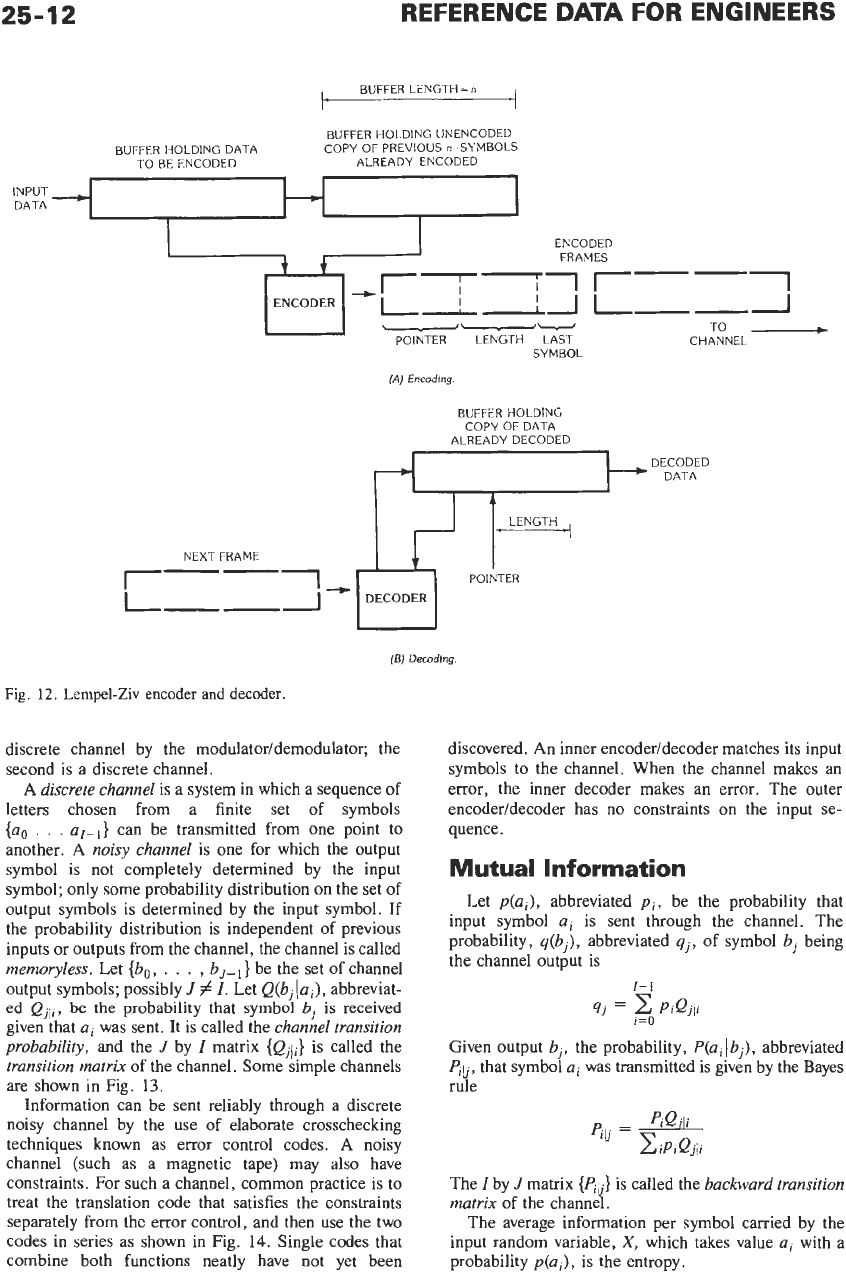
25-12
NEXT FRAME
REFERENCE
DATA
FOR ENGINEERS
I
LENGTH
BUFFER LENGTH
=
n
I I
BUFFER HOLDING UNENCODED
COPY OF PREVIOUS
n
-SYMBOLS
BUFFER HOLDING DATA
TO BE ENCODED ALREADY ENCODED
ENCODED
FRAMES
-1
ll
I-
I!II
L--l
-I-
TO
L
CHANNEL
I
I---.--+-
POINTER LENGTH LAST
SYMBOI
(A)
Encoding.
BUFFER HOLDING
COPYOFDATA
ALREADY DECODED
(E)
Decoding.
Fig.
12.
Lempel-Ziv encoder
and
decoder.
discrete channel by the modulator/demodulator; the
second is a discrete channel.
A
discrete channel
is a system in which a sequence of
letters chosen from a finite set of symbols
{ao
. . .
a[-,}
can be transmitted from one point to
another.
A
noisy channel
is one for which the output
symbol is not completely determined by the input
symbol; only some probability distribution on the set of
output symbols is determined by the input symbol. If
the probability distribution is independent
of
previous
inputs or outputs from the channel, the channel is called
memoiyless.
Let
{bo,
.
.
.
,
b,-,}
be the set of channel
output symbols; possibly
J
#
I.
Let
Q(bjlai),
abbreviat-
ed
Qjii,
be the probability that symbol
bj
is
received
given that
ai
was sent. It is called the
channel transition
probability,
and the
J
by
I
matrix
{ej\!}
is called the
transition matrix
of the channel. Some simple channels
are
shown in Fig. 13.
Information can be sent reliably through a discrete
noisy channel by the use
of
elaborate crosschecking
techniques known as error control codes.
A
noisy
channel (such as a magnetic tape) may also have
constraints. For such a channel, common practice is to
treat the translation code that satisfies the constraints
separately from the error control, and then use the two
codes in series as shown in Fig. 14. Single codes that
combine both functions neatly have not yet been
discovered. An inner encoderldecoder matches its input
symbols to the channel. When the channel makes an
error, the inner decoder makes an error. The outer
encodeddecoder has no constraints
on
the input se-
quence.
Mutual
Information
Let
p(ai),
abbreviated
pi,
be the probability that
input symbol
a,
is sent through the channel. The
probability,
q(bj),
abbreviated
qj,
of symbol
b,
being
the channel output is
I-
1
Given output
bj,
the probability,
P(ai
lbj),
abbreviated
plb,
that symbol
ai
was transmitted is given by the Bayes
rule
The
I
by
J
matrix
{elj}
is called the
backward transition
matrix
of the channel.
The average information per symbol carried by the
input random variable,
X,
which takes value
a,
with a
probability
p(ai),
is the entropy.
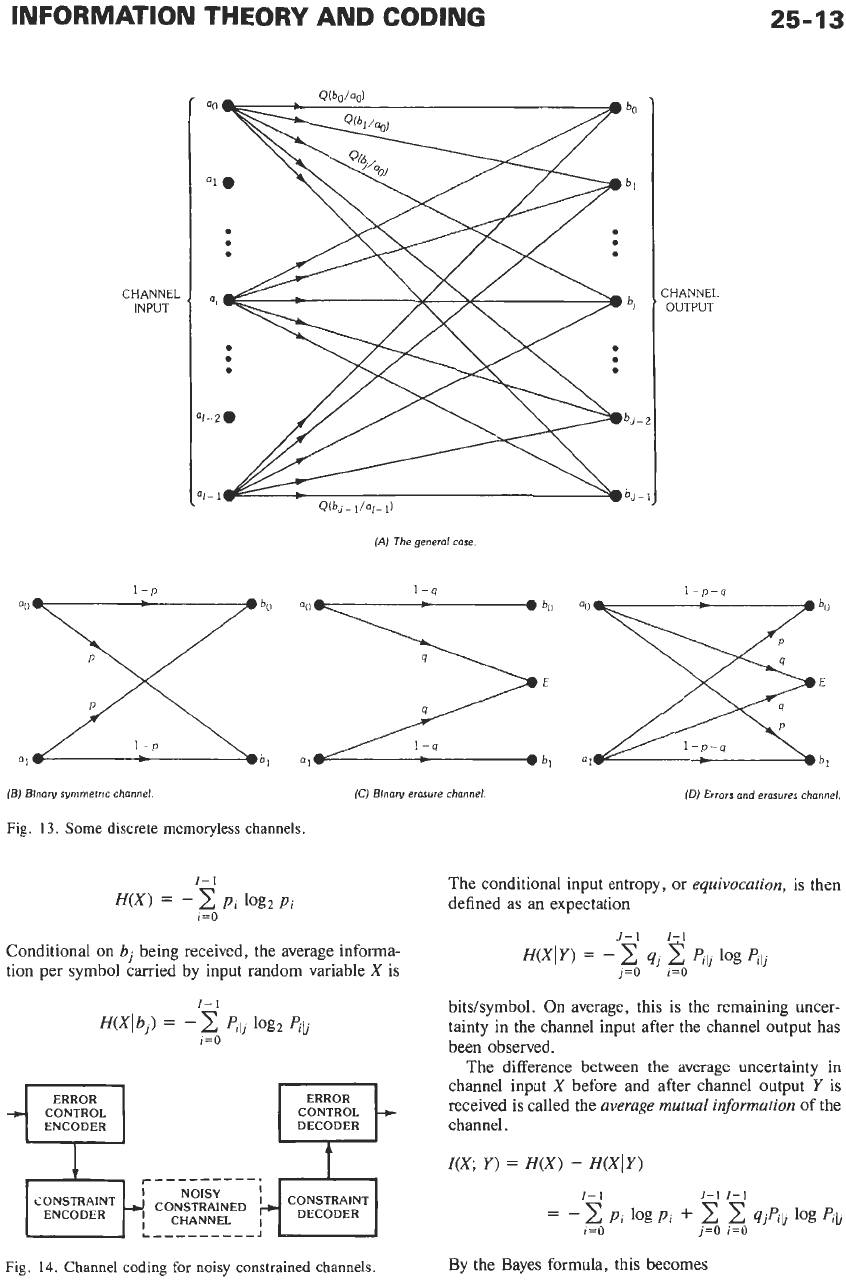
INFORMATION THEORY
AND
CODING
25-13
CHANNEL
INPUT
1-0
(A)
The general case.
1-0
CHANNEL
OUTPUT
(Bj
Blnary symmetric channel.
(C)
Blnary erasure channel.
(0)
Errors and erasures channel.
Fig.
13.
Some discrete memoryless channels.
I-
1
H(X)
=
-
pi
log2
pi
i=O
Conditional on
bj
being received, the average informa-
tion per symbol carried by input random variable
X
is
I-
1
i=O
H(Xlbj)
=
--E
pllj
log*
plk
CONTROL
ENCODER
CONTROL
DECODER
CONSTRAINT
NOISY
CHANNEL
I
‘::zEr
CONSTRAINED
4
DECODER
1
-
L
----_--__
J
-
Fig.
14.
Channel coding for
noisy
constrained
channels.
The conditional input entropy, or equivocation,
is
then
defined as an expectation
bitshymbol. On average, this is the remaining uncer-
tainty in the channel input after the channel output has
been observed.
The difference between the average uncertainty in
channel input
X
before and after channel output
Y
is
received is called the average mutual information
of
the
channel.
Z(X;
Y)
=
H(X)
-
H(XIY)
I-
I
J-I
1-1
=
-
pi
log
pi
+
C.
4jp1.k
log
p1.k
i=O
j=o
j=o
By the Bayes formula, this becomes
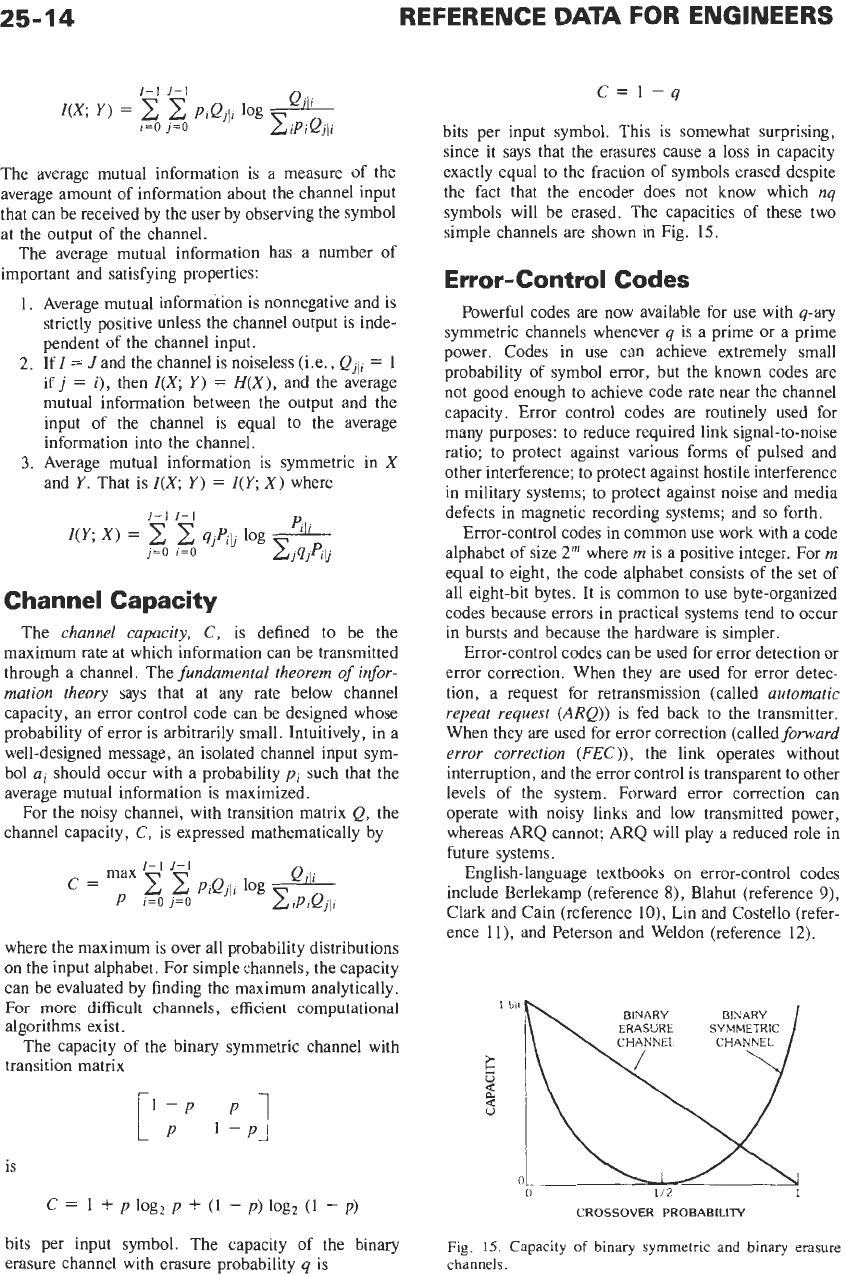
REFERENCE
DATA
FOR ENGINEERS
C=l-q
bits per input symbol. This is somewhat surprising,
since it says that the erasures cause a loss in capacity
exactly equal to the fraction of symbols erased despite
the fact that the encoder does not know which
nq
symbols will be erased. The capacities of these two
simple channels are shown in Fig.
15.
The average mutual information is a measure of the
average amount of information about the channel input
that can be received by the user by observing the symbol
at the output of the channel.
The average mutual information has a number of
important and satisfying properties:
Error-Control Codes
Average mutual information is nonnegative and is
strictly positive unless the channel output is inde-
pendent of the channel input.
If
I
=
J
and the channel is noiseless (i.e., Qjji
=
1
if
j
=
i),
then
I(X,
Y)
=
H(X),
and the average
mutual information between the output and the
input of the channel is equal to the average
information into the channel.
Average mutual information is symmetric in
X
and
Y.
That is
I(X;
Y)
=
Z(Y;
X)
where
Y
j=O
Z(Y;
X)
=
I-
I
Channel Capacity
The channel capacity,
C,
is defined to be the
maximum rate at which information can be transmitted
through a channel. The fundamental theorem
of
infor-
mation theory says that at any rate below channel
capacity, an error control code can be designed whose
probability of error is arbitrarily small. Intuitively, in a
well-designed message, an isolated channel input sym-
bol
a,
should occur with a probability
pi
such that the
average mutual information is maximized.
For the noisy channel, with transition matrix Q, the
channel capacity,
C,
is expressed mathematically by
where the maximum is over all probability distributions
on the input alphabet. For simple channels, the capacity
can be evaluated by finding the maximum analytically.
For
more difficult channels,
efficient
computational
algorithms exist.
The capacity of the binary symmetric channel with
transition matrix
is
c
=
1
+
p
log,
p
+
(I
-
p)
log* (1
-
p)
bits per input symbol. The capacity of the binary
erasure channel with erasure probability
q
is
~~
Powerful codes are now available for use with
q-ary
symmetric channels whenever
q
is a prime or a prime
power. Codes in use can achieve extremely small
probability of symbol error, but the known codes are
not good enough to achieve code rate near the channel
capacity. Error control codes are routinely used for
many purposes: to reduce required link signal-to-noise
ratio; to protect against various forms of pulsed and
other interference; to protect against hostile interference
in military systems; to protect against noise and media
defects in magnetic recording systems; and
so
forth.
Error-control codes in common use work with a code
alphabet of size
2"
where
rn
is a positive integer. Form
equal to eight, the code alphabet consists of the set of
all eight-bit bytes. It is common to use byte-organized
codes because errors in practical systems tend to occur
in bursts and because the hardware is simpler.
Error-control codes can be used for error detection or
error correction. When they are used for error detec-
tion, a request for retransmission (called automatic
repeat request (ARQ)) is fed back to the transmitter.
When they are used for error correction (calledfomard
error correction
(FEC)),
the link operates without
interruption, and the error control is transparent to other
levels of the system. Forward error correction can
operate with noisy links and low transmitted power,
whereas ARQ cannot; ARQ will play a reduced role in
future systems.
English-language textbooks on error-control codes
include Berlekamp (reference
8),
Blahut (reference
9),
Clark and Cain (reference lo), Lin and Costello (refer-
ence 1 l), and Peterson and Weldon (reference 12).
\
CHANNEL
CHANNEL
/
CROSSOVER PROBABILITY
Fig.
15.
Capacity
of
binary
symmetric
and
binary
erasure
channels.
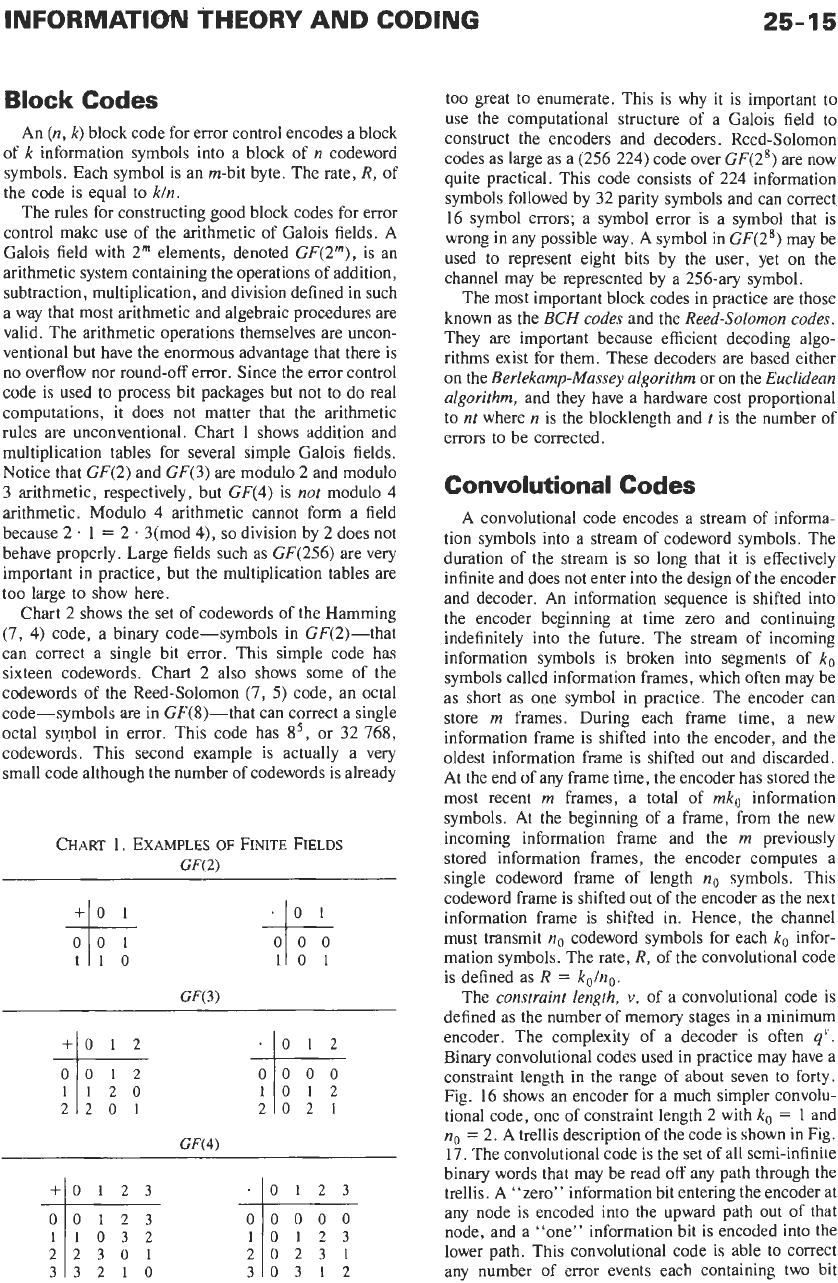
INFORMATlW THEORY AND CODING
25-15
Block
Codes
An
(n,
k)
block code for error control encodes a block
of
k
information symbols into a block of
n
codeword
symbols. Each symbol is an m-bit byte. The rate,
R,
of
the code is equal to
kln.
The rules for constructing good block codes for error
control make use of the arithmetic of Galois fields. A
Galois field with 2m elements, denoted GF(2m), is an
arithmetic system containing the operations of addition,
subtraction, multiplication, and division defined in such
a way that most arithmetic and algebraic procedures are
valid. The arithmetic operations themselves are uncon-
ventional but have the enormous advantage that there is
no overflow nor round-off error. Since the error control
code is used to process bit packages but not to do real
computations, it does not matter that the arithmetic
rules are unconventional. Chart
1
shows addition and
multiplication tables for several simple Galois fields.
Notice that GF(2) and GF(3) are modulo 2 and modulo
3 arithmetic, respectively, but GF(4) is
not
modulo 4
arithmetic. Modulo 4 arithmetic cannot form a field
because 2
~ 1
=
2
.
3(mod 4),
so
division by
2
does not
behave properly. Large fields such as GF(2.56) are very
important in practice, but the multiplication tables are
too large to show here.
Chart 2 shows the set of codewords of the Hamming
(7,
4) code, a binary code-symbols in GF(2)-that
can correct a single bit error. This simple code has
sixteen codewords.
Chart 2 also shows some of the
codewords of the Reed-Solomon
(7,
5)
code, an octal
code-symbols are in GF(8)-that can correct a single
octal symbol in error. This code has 8’, or 32 768,
codewords. This second example is actually a very
small code although the number of codewords is already
CHART 1. EXAMPLES
OF
FINITE FIELDS
GF(2)
~*
*
GF(3)
*
2201
2021
y;
.~0123
00000
1032 10123
2301 20231
3210 30312
too great to enumerate. This is why it is important
to
use the computational structure of a Galois field to
construct the encoders and decoders.
Reed-Solomon
codes as large as a (256 224) code over GF(28) are now
quite practical. This code consists of 224 information
symbols followed by 32 parity symbols and can correct
16 symbol errors; a symbol error is a symbol that is
wrong in any possible way. A symbol in GF(2*) may be
used to represent eight bits by the user, yet on the
channel may be represented by a 256-ary symbol.
The most important block codes in practice are those
known as the
BCH codes
and the
Reed-Solomon codes.
They are important because efficient decoding algo-
rithms exist for them. These decoders are based either
on the
Berlekamp-Massey algorithm
or on the
Euclidean
algorithm,
and they have a hardware cost proportional
to
nt
where
n
is the blocklength and
t
is the number of
errors to be corrected.
Convolutional Codes
A convolutional code encodes a stream of informa-
tion symbols into a stream of codeword symbols. The
duration of the stream is
so
long that it is effectively
infinite and does not enter into the design of the encoder
and decoder. An information sequence is shifted into
the encoder beginning at time zero and continuing
indefinitely into the future. The stream of incoming
information symbols is broken into segments
of
k,
symbols called information frames, which often may be
as short
as
one symbol in practice. The encoder can
store
m
frames. During each frame time, a new
information frame is shifted into the encoder, and the
oldest information frame is shifted out and discarded.
At the end of any frame time, the encoder has stored the
most recent
m
frames, a total of
mk,
information
symbols. At the beginning of a frame, from the new
incoming information frame and the
rn
previously
stored information frames, the encoder computes a
single codeword frame of length
no
symbols. This
codeword frame is shifted out of the encoder as the next
information frame is shifted in. Hence, the channel
must transmit
no
codeword symbols for each
ko
infor-
mation symbols. The rate,
R,
of the convolutional code
is defined as
R
=
ko/no.
The
constraint length,
v,
of a convolutional code is
defined as the number of memory stages in a minimum
encoder. The complexity of a decoder is often
4’.
Binary convolutional codes used in practice may have a
constraint length in the range
of
about seven
to
forty.
Fig. 16 shows an encoder for a much simpler convolu-
tional code, one of constraint length 2 with
ko
=
1
and
no
=
2. A trellis description of the code is shown in Fig.
17.
The convolutional code
is
the set of all semi-infinite
binary words that may be read off any path through the
trellis. A “zero” information bit entering the encoder at
any node is encoded into the upward path out of that
node, and a “one” information bit is encoded into the
lower path. This convolutional code is able to correct
any number of error events each containing two bit
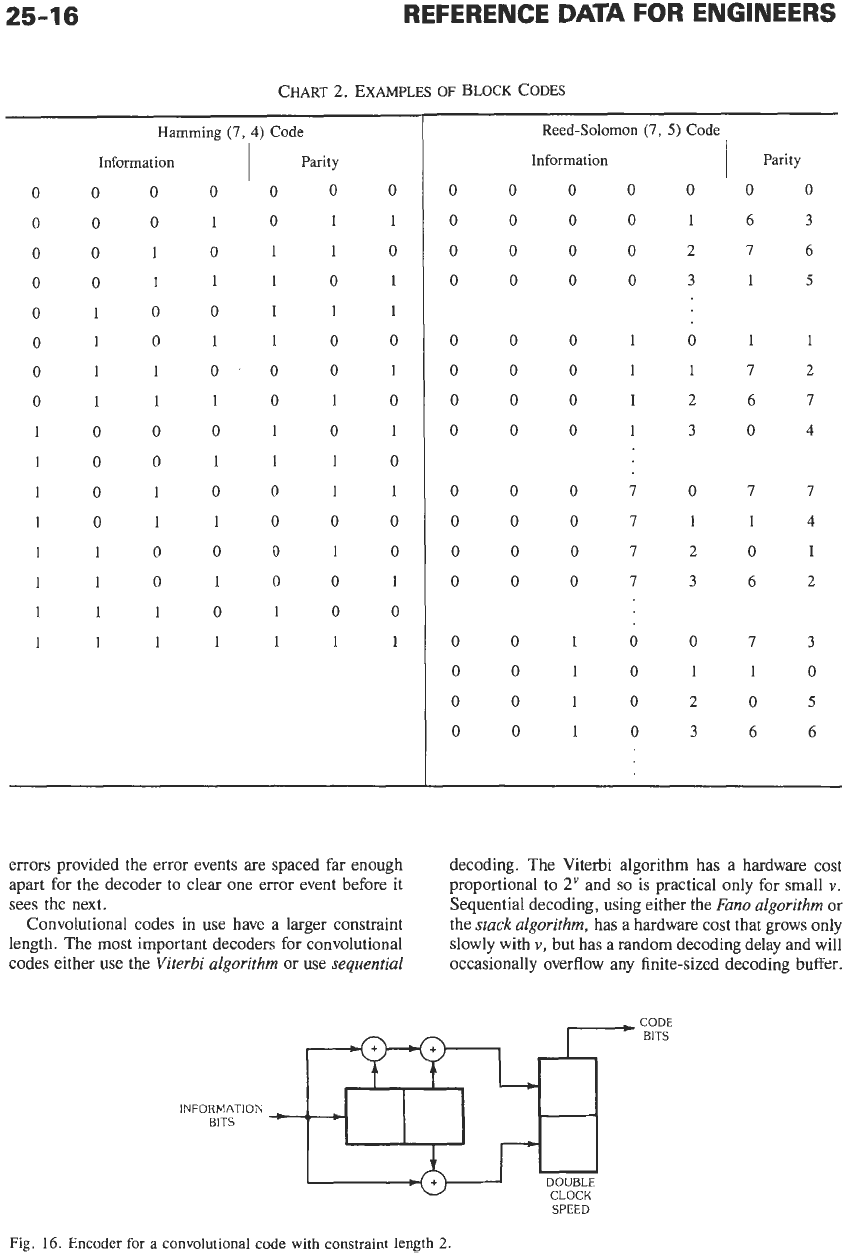
25-16
REFERENCE
DATA
FOR ENGINEERS
CHART
2.
EXAMPLES
OF
BLOCK
CODES
Hamming
(7,
4)
Code
Information Parity
0
0 0
0
0
0
0
0
0
0
1
0
1 1
0
0
1
0
1
1
0
I
0
0
1
1
1
0
1
0
1
0
0
1
1
1
0
1
0
1
1
0
0
0
1
1
0’
0
0
1
0
1
1 1
0
1
0
1
0
0 0
1
0
1
1
0
0
1
1
1
0
1
0
1
0
0
1
1
1
0
1
1
0 0 0
1
1
0
0
0
1
0
1
1
0
1
0
0
1
1
1
1
0
1
0 0
1 1
1
1
1 1
1
Reed-Solomon
(7,
5)
Code
Information Parity
0
0
0
0
0 0
0
0
0
0
0
1
6
3
0
0
0 0
2
7
6
0
0
0
0
3
1
5
0
0
0
1
0
1
1
0 0
0
1
1
7
2
0 0 0
1
2
6
7
0 0
0
1
3
0
4
0
0
0
7
0
7
7
0
0
0
7
1
1
4
0 0
0
7
2
0
1
0
0
0
7
3
6
2
0
0
1
0 0
7
3
0
0
1
0
1 1
0
0
0
1
0
2
0
5
0
0
1
0
3
6
6
errors provided the error events are spaced far enough
apart for the decoder
to
clear one error event before it
sees the next.
Convolutional codes in use have
a
larger constraint
length. The
most
important decoders for convolutional
codes either use the
Viterbi algorithm
or
use
sequential
decoding. The Viterbi algorithm has a hardware cost
proportional to
2”
and
so
is practical only for small
v.
Sequential decoding, using either the
Fano algorithm
or
the
stack algorithm,
has a hardware cost that grows only
slowly with
v,
but has a random decoding delay and will
occasionally overflow any finite-sized decoding buffer.
CLOCK
SPEED
Fig.
16.
Encoder
for
a
convolutional code
with
constraint
length
2.
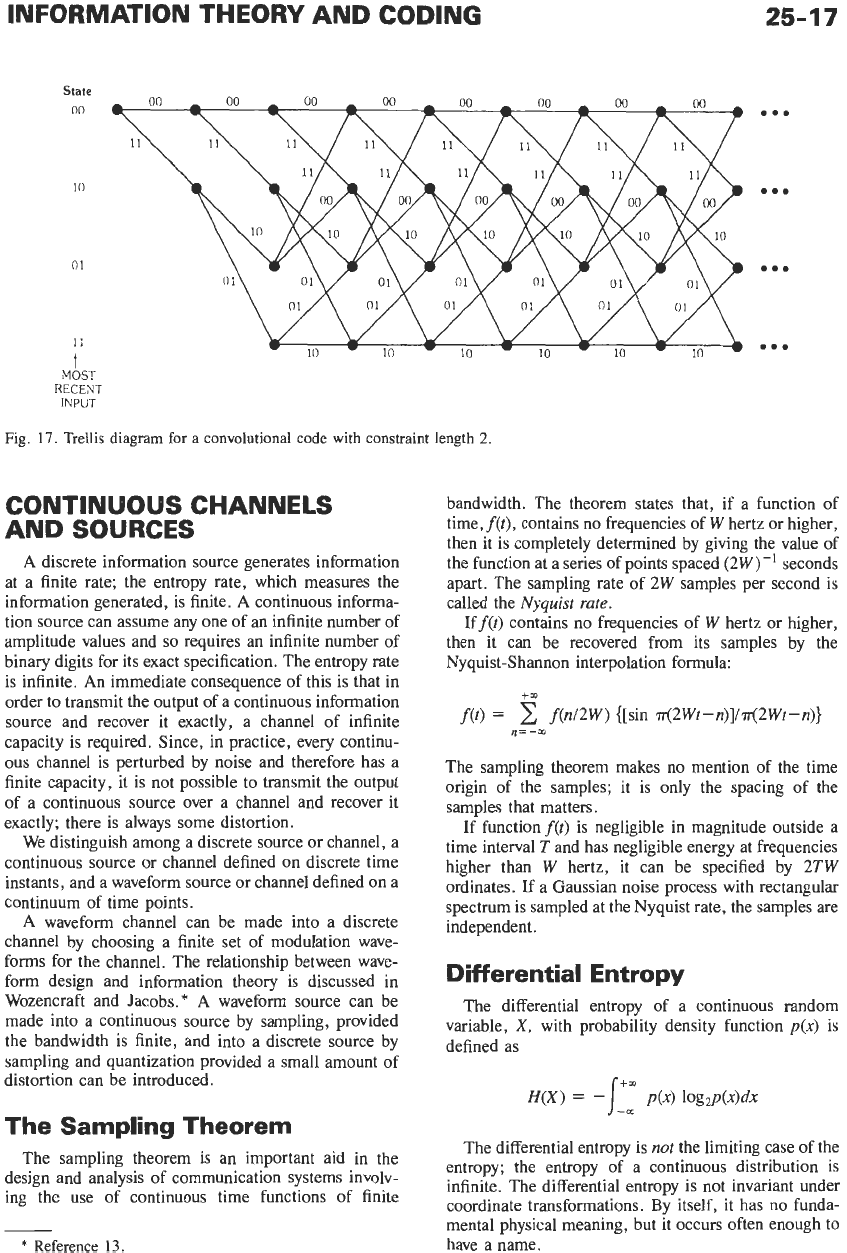
INFORMATION THEORY AND CODING
25-17
State
00
10
01
11
t
MOST
RECENT
INPUT
Fig.
17.
Trellis diagram
for
a
convolutional code
with
constraint length
2.
CONTINUOUS CHANNELS
AND SOURCES
A discrete information source generates information
at a finite rate; the entropy rate, which measures the
information generated, is finite. A continuous informa-
tion source can assume any one of an infinite number of
amplitude values and
so
requires an infinite number of
binary digits for its exact specification. The entropy rate
is infinite. An immediate consequence of this is that in
order to transmit the output of a continuous information
source and recover it exactly, a channel of infinite
capacity is required. Since, in practice, every continu-
ous channel is perturbed by noise and therefore has a
finite capacity, it is not possible to transmit the output
of a continuous source over a channel and recover it
exactly; there is always some distortion.
We distinguish among a discrete source or channel, a
continuous source or channel defined on discrete time
instants, and a waveform source or channel defined on a
continuum of time points.
A waveform channel can be made into a discrete
channel by choosing a finite set of modulation wave-
forms for the channel. The relationship between wave-
form design and information theory
is
discussed in
Wozencraft and Jacobs.* A waveform source can be
made into a continuous source by sampling, provided
the bandwidth
is
finite, and into a discrete source by
sampling and quantization provided a small amount
of
distortion can be introduced.
The Sampling Theorem
The sampling theorem is an important aid in the
design and analysis of communication systems involv-
ing the use of continuous time functions
of
finite
*
Reference 13.
bandwidth. The theorem states that, if a function of
time,f(t), contains no frequencies of
W
hertz or higher,
then it is completely determined by giving the value of
the function at a series of points spaced
(2W)-'
seconds
apart. The sampling rate of
2W
samples per second is
called the
Nyquist
rate.
If
f(t)
contains no frequencies of
W
hertz or higher,
then it can be recovered from its samples by the
Nyquist-Shannon interpolation formula:
+so
f(t)
=
f(n/2~)
{[sin
.~(2~t-n)l/.~(2~t-n)}
The sampling theorem makes no mention of the time
origin of the samples; it is only the spacing of the
samples that matters.
If function
f(t)
is negligible in magnitude outside a
time interval
T
and has negligible energy at frequencies
higher than
W
hertz, it can be specified by
2TW
ordinates. If a Gaussian noise process with rectangular
spectrum is sampled at the Nyquist rate, the samples are
independent.
n=
-x
Differential Entropy
The differential entropy of a continuous random
variable,
X,
with probability density function
p(x)
is
defined as
H(X)
=
-!+m
-00
p(x)
logfl(x)dx
The differential entropy is
not
the limiting case
of
the
entropy; the entropy of a continuous distribution is
infinite. The differential entropy is not invariant under
coordinate transformations. By itself, it has no funda-
mental physical meaning, but it occurs often enough to
have a name.
